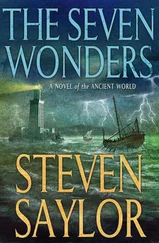The call for a light on the Bell Rock grew louder. If there had been a lighthouse, shipowners argued, many more ships would have made for the safety of the Firth of Forth. The Northern Lighthouse Board began, at last, to give serious consideration to what they still saw as an insoluble problem and Stevenson was quick to present his own plan for a beacon-style lighthouse on cast-iron pillars. Although there was not a more dangerous situation ‘upon the whole coasts of the Kingdom,’ he argued, his design would be safe, relatively inexpensive and even pay for itself as the board collected fees from ships taking advantage of its warning light. The cautiously minded board was impressed with the idea of economy, but less sure of Stevenson’s design.
Despite his experience around the coast of Scotland, Stevenson had not yet managed to set foot on Bell Rock itself and was impatient to do so. In April 1800, he hired a boat, intending to survey the site, but the weather was too stormy to land. In May, as he sailed nearby on a journey north, it lay invisible, even at low tide. He had to wait until the neap tides of October before he could make the attempt again. At the last minute, however, the boat he had been promised was unavailable and no one was prepared to take him out to the rock, not even in calm seas. Time was running out for a landing on the rock before winter and, if he could not find a boat, he would miss the favourable tides. Finally, a fisherman was found who was prepared to take the risk; it transpired the man often braved the Bell Rock to hunt for valuable wreckage to supplement his income.
Once on the rock, Stevenson and his friend, the architect James Haldane, had just two hours in which to assess the possibilities that the rock might offer before the tide returned and the rock disappeared. It was covered in seaweed and very slippery. The surface was pitted and sea water gurgled and sucked in the fissures and gullies that criss-crossed the rock, but Stevenson was encouraged by what he saw. The exposed area at low tide was about 250 by 130 feet, revealing enough room for a lighthouse. Better still the surface of the rock was of very hard sandstone, perfect for building.
There was one problem though. He had thought that a lighthouse on pillars would offer less resistance to the sea, but when he saw the heavy swell around the rock, overwhelming the channels and inlets, pushing its bullying foamy waters into deep fissures even on a calm day, he knew his plan could not work. Visiting boats bringing supplies or a change of keeper would be shattered against the pillars in heavy seas, and the capability of the pillars to withstand the timeless beating of the waves was questionable, too. ‘I am sure no one was fonder of his own work than I was, until I saw the Bell Rock,’ he wrote. ‘I had no sooner landed than I saw my pillars tumble like the baseless fabric of a dream.’
The two hours passed all too quickly. The fisherman, who had gathered spoils from wreckage on the reef, was anxious to leave as the returning tide swirled around their feet. For Stevenson, finding the Bell Rock and standing at the centre of its watery kingdom, with nothing but the ever-encroaching sea in sight, had been a revelation. It was clear that only an immensely strong tower would have a chance of surviving in such an exposed position – a building higher than the highest waves, made of solid sandstone and granite. With these thoughts in mind, he undertook an extensive tour of English lighthouses and harbour lights in search of a model on which to base his own plans. It was a journey of some two and a half thousand miles by coach or on horseback, which took many months of 1801. He soon found there was only one such stone sea-tower already in existence. It was built on a buttress of rock about nine miles from the port of Plymouth, off the south coast in Cornwall.
The Eddystone Lighthouse, so called because of the dangerous eddies and currents that swirled around it, had withstood the fearsome gales blown in from the Atlantic since 1759. It had been built by John Smeaton, a man revered by Stevenson and considered to be the father of the civil engineering profession. Standing 70 feet high, it was made from interlocking solid Portland stone and granite blocks, which presented a tall, smooth curved shape to the elements. It had been inspired, Smeaton said, by the trunk of an oak tree. ‘An oak tree is broad at its base,’ he explained, ‘curves inward at its waist and becomes narrower towards the top. We seldom hear of a nature oak tree being uprooted.’
There had been several attempts at lighthouses on the Eddystone rocks before Smeaton’s triumphant endeavour, the most notable being the Winstanley Lighthouse, built in 1698. Henry Winstanley, the clerk of works at Audley End in Essex, was also an enthusiastic inventor and he took it upon himself to build a remarkable six-sided structure on the Eddystone rocks standing over 100 feet high. With charming balconies, gilded staterooms, decorative wrought-iron work and casement windows for fishing, the whole curious structure was topped with an octagonal cupola complete with flags, more wrought iron and a weather vane. It might have been more appropriately placed as a folly on a grand estate, but Winstanley was confident it could withstand the most furious of storms. He was so confident that he longed to be there in bad weather to observe the might of the sea and by chance he was there on 26 November 1703. That night a bad storm blew in with horizontal rain, screaming winds and waves 100 feet high. Winstanley certainly had his wish. At some time in the night, the fury of the sea took Winstanley and his pretty gilded lighthouse and tossed them to a watery oblivion. In the morning, nothing remained but a few pieces of twisted wire.
On his return from his trip in September, Stevenson immediately set about redesigning his lighthouse along the lines of Smeaton’s Eddystone. He, too, would build a solid tower that curved inwards, the walls narrowing with height and accommodating the keeper’s rooms. It would have to be at least twenty feet taller than the Eddystone, which was built on a rock above sea level, unlike the Bell Rock, which at high tide was covered by eleven to sixteen feet of water. And if it was to be taller, it would also have to be wider at the base, over 40 feet, with solid, interlocking granite stone that would ensure it was invulnerable, even in roaring seas. More than 2,500 tons of stone would be needed and Stevenson calculated that the cost of such a lighthouse would be around £42,000.
He could foresee that this cost would be a major obstacle as the annual income collected by the Northern Lighthouse Board from dues was a modest £4,386. He was right; the board thought the cost prohibitive and also questioned Stevenson’s ability to undertake such an immense and difficult project. They felt he was too young and untried for this great responsibility and pointed out that he had in fact only ever built one lighthouse before, a small lighthouse at that, and on the mainland. The board made it clear that they intended consulting established men in the civil engineering profession, men with a body of work and high reputation, such as John Rennie, who was building the London Docks.
But Stevenson was a man who stood four-square to an unfavourable wind. The sweet wine of optimism flowed in his veins in generous measure and he took the negative epistle from the board as a simple invitation to his buccaneering spirit to try again. Meanwhile the commissioners of the Northern Lighthouse Board realised they would never generate alone the huge sum needed for a lighthouse on the Bell Rock. It would need an Act of Parliament to allow them to borrow the required amount, which they would then repay from the shipping dues they collected.
The first Bill was rejected in 1803, but the subject was far from forgotten. The board was still hopeful for some sort of light and made it known that they would give consideration to any sensible plan that was submitted. A Captain Brodie stepped forward with his plan for a lighthouse on four pillars made of cast iron and a generous offer to provide, at his own expense, a temporary light until a permanent structure was in place. The board quietly shelved the lighthouse on cast-iron pillars but encouraged the temporary lights, which duly appeared, built of wood. And as each one was toppled by careless seas, it was replaced by Captain Brodie with growing impatience. Several budding engineers had proposed plans for a lighthouse on pillars, including one advocating hollow pillars, to be filled every tide by the sea, but the conservative-minded members of the Northern Lighthouse Board remained unconvinced.
Читать дальше












